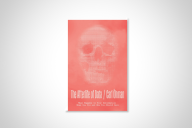You have /5 articles left.
Sign up for a free account or log in.
At the start of a course of lectures on Aristotle in the 1920s, Martin Heidegger made a terse remark about the relevance of biography to the philosopher’s task when considering the work of a predecessor. “Regarding the personality of a philosopher,” he said, “our only interest is that he was born at a certain time, that he worked, and that he died."
The rest is gossip – interesting, perhaps, but a diversion of no serious import. Heidegger’s statement expresses the attitude in its purest and most severe form, with a hint of disdain for the public outside the auditorium. Such was the default attitude for the German mandarin professor of the day. (Heidegger gave the lecture far too early for us to assume any taint of rationalization by someone who joined the Nazis in 1933 and held a membership card for a dozen years.)
What would he have made of Steven Nadler’s The Philosopher, the Priest, and the Painter: A Portrait of Descartes (Princeton University Press)? It is, in effect, the biography of a painting. It does not grapple with René Descartes’s role in the history of Being. It tells us how we know what the philosopher looked like. One imagines Heidegger holding the book up to show his students, then throwing it out the window.
… which is, in its own way, a recommendation. Descartes wrote his Discourse on Method and Meditations on First Philosophy -- among the really epochal works in the history of human thought -- in the first person, with occasional mention of the life he led before building up an understanding of the world on the secure foundations of the cogito. If interest in the man himself marks the reader as a plebeian, well, there are worse intellectual vices than curiosity. And anyway, I’ve long been sympathetic to Saul Bellow’s character Herzog, muddling through midlife by writing letters he doesn’t send: “Dear Doktor Professor Heidegger, I should like to know what you mean by the expression ‘the fall into the quotidian.’ When did this fall occur? Where were we standing when it happened?”
A number of biographies of Descartes have appeared of late -- and Nadler, a professor of philosophy at the University of Madison at Wisconsin, wisely does not try to compete with them for depth or detail. When Stephen Gaukroger’s Descartes: An Intellectual Biography came out in the mid-1990s, for example, its treatment of the philosopher’s engagement with 17th-century physics set the bar for new contributions on that topic awfully high. It covered as much about the corpuscular theory of matter as any reader would ever require for context, and then some. (And, it seems, far more than I had any chance of retaining after all these years.)
Given the breadth of Descartes’s interests and the continent-spanning range of his personal contacts (through travel) and his public audience (through Latin), we shall never want for books on him of staggering erudition and equally staggering length. Nadler’s project, rather, is one of concentration, starting with a familiar portrait of Descartes hanging in the Louvre and moving from doubts about who created it to a rich but trim account of how its prototype – a painting from 1649, attributed to the Dutch master Frans Hals working in his “rough” style – came to be commissioned by the philosopher’s friend Augustijn Bloemaert, a Catholic priest with his own extensive network of artistic and intellectual associates.
What takes shape behind the portrait, then, is a landscape (or at least a well-turned charcoal sketch) of religious, artistic, and economic life in the Netherlands during the first half of the 17th century. Descartes’s philosophical and scientific writings were addressed to a transnational public, but Nadler’s angle of vision also situates them within a local scene. For one, his major works were published in Amsterdam by a prominent scholarly press that had been established in 1580 by one Lodewijk Elzevier. (The firm went out of business in 1713, but the brand was re-established, with a slight change of spelling, in 1880, and remains profitable, to say the least.)
Nadler tries to challenge the image of Descartes as “the aloof, solitary, and misanthropic genius that his contemporary critics and some later commentators have made him out to be.” That takes some doing. The philosopher’s letters suggest an irascible person. But he also remained enough of a Roman Catholic (intellectual combat with the church notwithstanding) to find in Father Bloemaert not just a friend but someone who could calm his pangs of conscience.
In reading the philosopher's work, Nadler appears to share Stephen Gaukroger’s interpretation of radical doubt as Descartes's method for putting his own scientific research on the firmest possible foundations. Good physics requires solid metaphysics. (This interpretation differs from seeing Descartes as primarily responding to the 17th-century revival of Pyrrhonian skepticism, as everyone did when I was a lad.) The absolute certainty with which the cogito can say “cogito ergo sum” -- “I think, therefore I am” -- is less important as a conclusion than as a starting point. By going on from there to deduce what Nadler calls “the exhaustive and exclusive division of mind and body” – by establishing that “everything is either mental or physical” – Descartes can analyze everything happening in the physical universe as “explained by material principles alone.” Since God created those principles, as well as reason itself, theology will continue to play an honorable and necessary role – just not in the lab.
The fellow looking back at us from Frans Hals's canvas wears what strikes me as a shrewd expression: Descartes was a soldier and a man of the world before settling down to authorship. So it is hard to imagine how he ever persuaded himself that not only would his ideas be acceptable to the Vatican, but that the Jesuits might adopt one of his works as a textbook. That never happened, of course; instead, his works went on the index of prohibited books for a couple of centuries.
“By committing thought entirely to the back and forth of analysis and synthesis,” writes Peter Sloterdijk in Philosophical Temperaments: From Plato to Foucault, a volume of essays just published in translation by Columbia University Press, Descartes “made reason itself conform to engineering and stripped it of its ancient contemplative muse.” (Exactly the sort of thing Heidegger despised, to revisit our starting point.) The force unleashed by Descartes “rebuffed the claims of tradition and its professors,” Sloterdijk also writes: “he who has the power to begin anew need no longer engage in dialogues with the dead; he who turns a new page is for now exempt from the dialogue with history.”
This encapsulates much of what is stated and implied in The Philosopher, the Priest, and the Painter. At the same time, it describes a condition now taken for granted; we are 400 years into the modernity Descartes represents, and arguably inaugurated. What I like about Nadler’s book is that it takes us back upstream a ways -- beginning, rather than exempting us from, a dialogue with the dead.








